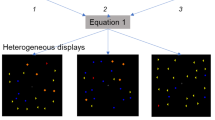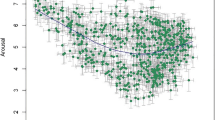Abstract
Object classification can be facilitated if simple diagnostic features can be used to determine class membership. Previous studies have found that simple shapes may be diagnostic for emotional content and automatically alter the allocation of visual attention. In the present study, we analyzed whether color is diagnostic of emotional content and tested whether emotionally diagnostic hues alter the allocation of visual attention. Reddish-yellow hues are more common in (i.e., diagnostic of) emotional images, particularly images with positive emotional content. An exogenous cueing paradigm was employed to test whether these diagnostic hues orient attention differently from other hues due to the emotional diagnosticity. In two experiments, we found that participants allocated attention differently to diagnostic hues than to non-diagnostic hues, in a pattern indicating a broadening of spatial attention when cued with diagnostic hues. Moreover, the attentional broadening effect was predicted by self-reported measures of affective style, linking the behavioral effect to emotional processes. These results confirm the existence and use of diagnostic features for the rapid detection of emotional content.




Similar content being viewed by others
Notes
However, one should note that this representation is not identical to that in the thalamus because it is based on a transformation of RGB image coordinates rather than the relative activation-level of photoreceptors with long, medium or short wavelength sensitivities. Using this more biologically accurate model requires physical measurements from the display used during original IAPS emotional rating task, which is not possible.
Two-dimensional color histograms were constructed using the H (hue) and S (saturation) dimensions, and the emotional versus non-emotional effect was significant for six highly-saturated reddish hues (peak effect was t(358) = 5.10).
References
Aronoff, J. (2006). How we recognize angry and happy emotion in people, places and things. Cross-cultural Research, 40(1), 83–105.
Aronoff, J., Barclay, A. M., & Stevenson, L. A. (1988). The recognition of threatening facial stimuli. Journal or Personality and Social Psychology, 54(4), 647–655.
Aronoff, J., Woike, B. A., & Hyman, L. M. (1992). Which are the stimuli in facial displays of anger and happiness? Configurational bases of emotion recognition. Journal or Personality and Social Psychology, 62(6), 1050–1066.
Attrill, M. J. (2008). Red shirt colour is associated with long-term team success in English football. Journal of Sports Sciences, 26, 577–582.
Bar, M., & Neta, M. (2007). Visual elements of subjective preference modulate amygdala activation. Neuropsychologia, 45.
Berlin, B., & Kay, P. (1969). Basic color terms. Berkeley: University of California Press.
Bradley, B. P., Mogg, K., Millar, N., & White, J. (1995). Selective processing of negative information: Effects of clinical anxiety, concurrent depression, and awareness. Journal of Abnormal Psychology, 104, 532–536.
Carver, C. S., & White, T. L. (1994). Behavioral inhibition, behavioral activation, and affective responses to impending reward and punishment: The BIS/BAS scales. Journal of Personality and Social Psychology, 67, 319–333.
Changizi, M. A., Zhang, Q., & Shimojo, S. (2006). Bare skin, blood and the evolution of primate colour vision. Biology Letters, 2(2), 217–221.
Codispoti, M., Ferrari, V., & Bradley, M. M. (2007). Repetition and event-related potentials: Distinguishing early and late processes in affective picture perception. Journal of Cognitive Neuroscience, 19(4), 577–586.
Davidson, R. J. (1993). Cerebral asymmetry and emotion: Conceptual and methodological conundrums. Cognition and Emotion, 7, 115–138.
Delplanque, S., N’diaye, K., Scherer, K., & Grandjean, D. (2007). Spatial frequencies or emotional effects? A systematic measure of spatial frequencies for IAPS pictures by a discrete wavelet analysis. Journal of Neuroscience Methods, 165(1), 144–150.
Elliot, A. J., & Maier, M. A. (2007). Color and psychological functioning. Current Directions in Psychological Science, 16(5), 250–254.
Elliot, A. J., Maier, M. A., Binser, M. J., Friedman, R., & Pekrun, R. (2009). The effect of red on avoidance behavior in achievement contexts. Personality and Social Psychology Bulletin, 35, 365–375.
Elliot, A. J., Maier, M. A., Moller, A. C., Friedman, R., & Meinhardt, J. (2007). Color and psychological functioning: The effect of red on performance attainment. Journal of Experimental Psychology: General, 136(1), 165–168.
Fredrickson, B. L. (2004). The broaden-and-build theory of positive emotions. Philosophical Transactions of the Royal Society: Biological Sciences, 359(1449), 1367–1377.
Gable, P. A., & Harmon-Jones, E. (2008). Approach-motivated positive affect reduces breadth of attention. Psychological Science, 19, 476–482.
Genovese, C. R., Lazar, N. A., & Nichols, T. (2002). Thresholding of statistical maps in functional neuroimaging using the false discovery rate. Neuroimage, 15(4), 870–878.
Goffaux, V., Jacques, C., Mouraux, A., Oliva, A., Schyns, P. G., & Rossion, B. (2005). Diagnostic colours contribute to the early stages of scene categorization: Behavioural and neurophysiological evidence. Visual Cognition, 12(6), 878–892.
Green, H. B., & Knapp, R. H. (1959). Time judgment, aesthetic preference, and need for achievement. Journal of Abnormal and Social Psychology, 58(1), 140–142.
Hagemann, N., Strauss, B., & Leiβing, J. (2008). When the referee sees red…. Psychological Science, 19(8), 769–771.
Haruno, M., Kuroda, T., Doya, K., Toyama, K., Kimura, M., Samejima, K., et al. (2004). A neural correlate of reward-based behavioral learning in caudate nucleus: A functional magnetic resonance imaging study of stochastic decision task. Journal of Neuroscience, 24, 1660–1665.
Heubeck, B. G., Wilkinson, R. B., & Cologon, J. (1998). A second look at Carver and White’s (1994) BIS/BAS scales. Personality and Individual Differences, 25, 785–800.
Hill, R. A., & Barton, R. A. (2005). Red enhances human performance in contests. Nature, 435(7040), 293.
Johnson, J. S., & Olshausen, B. A. (2003). Timecourse of neural signatures of object recognition. Journal of Vision, 3(7), 499–512.
Junghofer, M., Bradley, M. M., Elbert, T. R., & Lang, P. J. (2001). Fleeting images: A new look at early emotion discrimination. Psychophysiology, 38(02), 175–178.
Knapp, R. H. (1962). Attitudes toward time and aesthetic choice. The Journal of Social Psychology, 56, 79–87.
Koster, E. H. W., Crombez, G., Van Damme, S., Verschuere, B., & De Houwer, J. (2004). Does imminent threat capture and hold attention. Emotion, 4(3), 312–317.
Lake, D. A., & Bryden, M. P. (1976). Handedness and sex differences in hemispheric asymmetry. Brain and Language, 3(2), 266–282.
Lang, P. J., Bradley, M. M., & Cuthbert, B. N. (1995). International affective picture system (IAPS): Technical manual and affective ratings. Gainesville, FL: The Center for Research in Psychophysiology, University of Florida.
Larson, C. L., Aronoff, J., Sarinopoulos, I. C., & Zhu, D. C. (2009). Recognizing threat: A simple geometric shape activates neural circuitry for threat detection. Journal of Cognitive Neuroscience, (Early Access), pp 1–13.
Larson, C. L., Aronoff, J., & Stearns, J. J. (2007). The shape of threat: Simple geometric forms evoke rapid and sustained capture of attention. Emotion, 7(3), 526–534.
Leone, L. (2009). Testing conceptual distinctions among Carver and White’s (1994) BAS scales: A comment and extension on Smillie, Jackon and Dalgleish (2006). Personality and Individual Differences, 46, 54–59.
Leone, L., Perugini, M., Bagozzi, R. P., Pierro, A., & Mannetia, L. (2001). Construct validity and generalizability of the Carver-White behavioral inhibition system/behavioral activation system scales. European Journal of Personality, 15, 373–390.
Lichtenfeld, S., Maier, M. A., Elliot, A. J., & Pekrun, R. (2009). The semantic red effect: Processing the word red undermines intellectual performance. Journal of Social Psychology, 45, 1273–1276.
Liddell, B. J., Brown, K. J., Kemp, A. H., Barton, M. J., Das, P., Peduto, A., et al. (2005). A direct brainstem–amygdala–cortical ‘alarm’ system for subliminal signals of fear. Neuroimage, 24(1), 235–243.
Little, A. C., & Hill, R. A. (2007). Attribution to red suggests special role in dominance signaling. Journal of Evolutionary Psychology, 5(1), 161–168.
Lotto, R. B., & Purves, D. (2004). Perceiving color. Review of Progress in Coloration and Related Topics, 34, 12–25.
Maxwell, J. S., Shackman, A. J., & Davidson, R. J. (2005). Unattended facial expressions asymmetrically bias the concurrent processing of nonemotional information. Journal of Cognitive Neuroscience, 17(9), 1386–1395. doi:10.1162/0898929054985437.
Milinski, M., & Bakker, T. C. M. (1990). Female sticklebacks use male coloration in mate choice and hence avoid parasitized males. Nature, 344(6264), 330–333.
Mogg, K., Bradley, B. P., & Williams, R. (1995). Attentional bias in anxiety and depression: The role of awareness. The British Journal of Clinical Psychology, 34(Pt 1), 17–36.
Moller, A. C., Elliot, A. J., & Maier, M. A. (2009). Basic hue-meaning associations. Emotion, 9(6), 898–902.
Murphy, F. C., Sahakian, B. J., Rubinsztein, J. S., Michael, A., Rogers, R. D., Robbins, T. W., et al. (1999). Emotional bias and inhibitory control processes in mania and depression. Psychological Medicine, 29(6), 1307.
Nestor, A., & Tarr, M. J. (2008). Gender recognition of human faces using color. Psychological Science, 19(12), 1242–1246.
Nomura, E. M., & Reber, P. J. (2008). A review of medial temporal lobe and caudate contributions to visual category learning. Neuroscience and Biobehavioral Reviews, 32, 279–291.
Öhman, A., Flykt, A., & Esteves, F. (2001). Emotion drives attention: Detecting the snake in the grass. Journal of Experimental Psychology, 130(3), 466–478.
Oliva, A., & Schyns, P. G. (2000). Colored diagnostic blobs mediate scene recognition. Cognitive Psychology, 41, 176–210.
Pasley, B. N., Mayes, L. C., & Schultz, R. T. (2004). Subcortical discrimination of unperceived objects during binocular rivalry. Neuron, 42(1), 163–172.
Posner, M. I., & Petersen, S. E. (1990). The attention system of the human brain. Annual Reviews in Neuroscience, 13(1), 25–42.
Pryke, S. R., & Griffith, S. C. (2006). Red dominates black: Agonistic signaling among head morphs in the colour polymorphic gouldian finch. Proceedings of the Royal Society B: Biological Sciences, 273(1589), 949–957.
Ratcliff, R. (1993). Methods for dealing with reaction time outliers. Psychological Bulletin, 114, 510–532.
Schyns, P. G. (1998). Diagnostic recognition: Task constraints, object information, and their interactions. Cognition, 67(1–2), 147–179.
Segerstrom, S. C. (2001). Optimism and attentional bias for negative and positive stimuli. Personality and Social Psychology Bulletin, 27(10), 1334.
Setchell, J. M., & Wickings, E. (2005). Dominance, status signals and coloration in male mandrills (mandrillus sphinx). Ethology, 111(1), 25–50.
Smillie, L. D., Jackson, C. J., & Dalgleish, L. I. (2006). Conceptual distinctions among Carver and White’s (1994) scales: A reward-reactivity versus trait impulsivity perspective. Personality and Individual Differences, 40, 1039–1050.
Surridge, A. K., Osorio, D., & Mundy, N. I. (2003). Evolution and selection of trichromatic vision in primates. Trends in Ecology & Evolution, 18(4), 198–205.
Tanaka, J., Weiskopf, D., & Williams, P. (2001). The role of color in high-level vision. Trends in Cognitive Sciences, 5(5), 211–215.
Vuilleumier, P., Armony, J. L., Driver, J., & Dolan, R. J. (2003). Distinct spatial frequency sensitivities for processing faces and emotional expressions. Nature Neuroscience, 6(6), 624–631.
Wadlinger, H. A., & Isaacowitz, D. M. (2006). Positive mood broadens visual attention to positive stimuli. Motivation and Emotion, 30, 89–101.
Waitt, C. (2003). Evidence from rhesus macaques suggests that male coloration plays a role in female primate mate choice. Proceedings of the Royal Society B: Biological Sciences, 270, 144–146.
Walther, D. (2006). Appendix A. 2. Color opponencies for bottom-up attention. Interactions of visual attention and object recognition: Computational modeling, Algorithms, and psychophysics. Ph.D. Thesis, 98–99.
Watson, D. G., Blagrove, E., Evans, C., & Moore, L. (2012). Negative triangles: Simple geometric shapes convey emotional valence. Emotion, 12(1), 18–22.
Watson, D., Clark, L. A., & Tellegen, A. (1988). Development and validation of brief measures of positive and negative affect: The PANAS scales. Journal of Personality and Social Psychology, 54(6), 1063–1070.
Whalen, P. J. (1998). Fear, vigilance, and ambiguity: Initial neuroimaging studies of the human amygdala. Current Directions in Psychological Science, 7(6), 177–188.
Whalen, P. J., Kagan, J., Cook, R. G., Davis, F. C., Kim, H., Polis, S., et al. (2004). Human amygdala responsivity to masked fearful eye whites. Science, 306(5704), 2061.
Wurm, L. H., Legge, G. E., Isenberg, L. M., & Luebker, A. (1993). Color improves object recognition in normal and low vision. Journal of experimental psychology, 19, 899–911.
Zald, D. H. (2003). The human amygdala and the emotional evaluation of sensory stimuli. Brain Research Reviews, 41, 88–123.
Acknowledgments
BWM was supported by T32-HD007151.
Author information
Authors and Affiliations
Corresponding author
Appendix
Rights and permissions
About this article
Cite this article
McMenamin, B.W., Radue, J., Trask, J. et al. The diagnosticity of color for emotional objects. Motiv Emot 37, 609–622 (2013). https://doi.org/10.1007/s11031-012-9319-0
Published:
Issue Date:
DOI: https://doi.org/10.1007/s11031-012-9319-0




